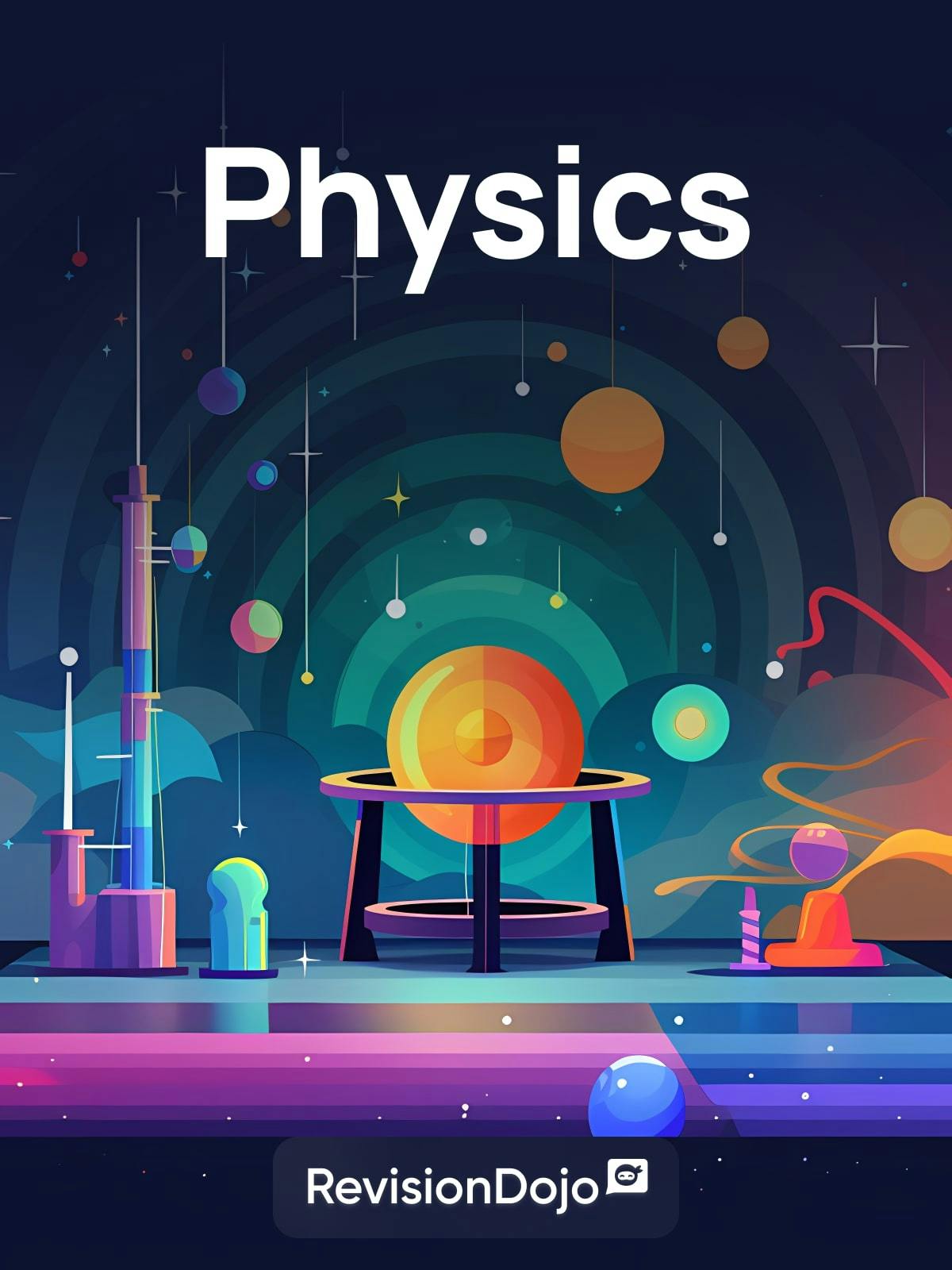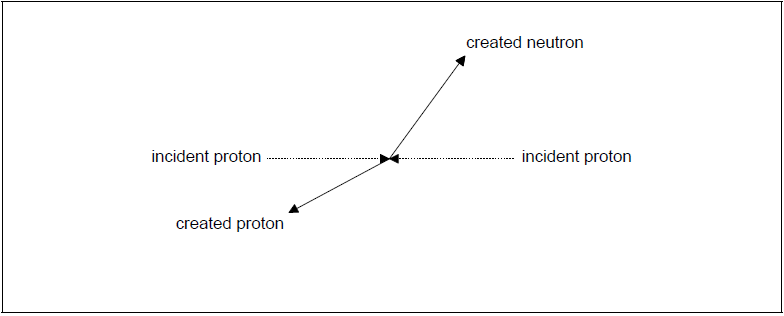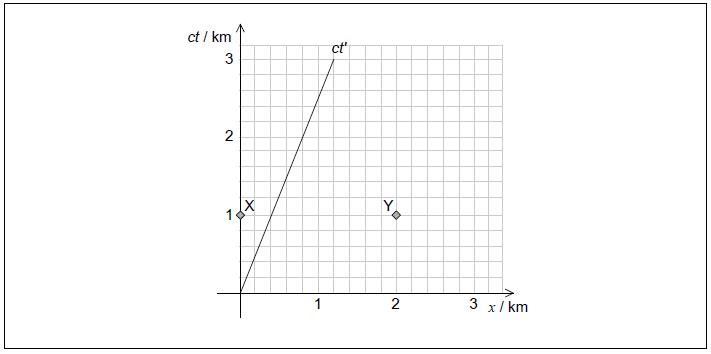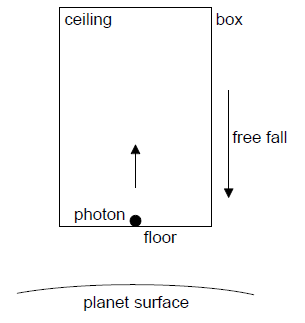
Option A - Relativity
Question 1
HLPaper 3Two protons, travelling in opposite directions, collide. Each has a total energy of 3.35 GeV.
As a result of the collision, the protons are annihilated and three particles, a proton, a neutron, and a pion are created. The pion has a rest mass of 140 MeVc-2. The total energy of the emitted proton and neutron from the interaction is 6.20 GeV.
Calculate the gamma () factor for one of the protons.
Determine, in terms of , the momentum of the pion.
The diagram shows the paths of the incident protons together with the proton and neutron created in the interaction. On the diagram, draw the path of the pion.

Question 2
SLPaper 3State one prediction of Maxwell's theory of electromagnetism that is consistent with special relativity.
A current is established in a long straight wire that is at rest in a laboratory.

A proton is at rest relative to the laboratory and the wire.
Observer X is at rest in the laboratory. Observer Y moves to the right with constant speed relative to the laboratory. Compare and contrast how observer X and observer Y account for any non-gravitational forces on the proton.
Question 3
HLPaper 3A lambda ^0 particle at rest decays into a proton and a pion according to the reaction
where the rest energy of = 938 MeV and the rest energy of = 140 MeV.
The speed of the pion after the decay is 0.579. For this speed = 1.2265. Calculate the speed of the proton.
Question 4
SLPaper 3Two rockets, A and B, are moving towards each other on the same path. From the frame of reference of the Earth, an observer measures the speed of A to be 0.6 and the speed of B to be 0.4. According to the observer on Earth, the distance between A and B is m.

Define frame of reference.
Calculate, according to the observer on Earth, the time taken for A and B to meet.
Identify the terms in the formula.
Determine, according to an observer in A, the velocity of B.
Determine, according to an observer in A, the time taken for B to meet
Deduce, without further calculation, how the time taken for A to meet B, according to an observer in B, compares with the time taken for the same event according to an observer in
Question 5
SLPaper 3A train is moving across a bridge with a speed . Observer A is at rest in the train. Observer B is at rest with respect to the bridge.
The length of the bridge according to observer B is 2.0 km.
According to observer B, two lamps at opposite ends of the bridge are turned on simultaneously as observer A crosses the bridge. Event X is the lamp at one end of the bridge turning on. Event Y is the lamp at the other end of the bridge turning on.

Events X and Y are shown on the spacetime diagram. The space and time axes of the reference frame for observer B are and . The line labelled is the worldline of observer A.

Calculate, for observer A,the length of the bridge a(i).
Calculate, for observer A, the time taken to cross the bridge.
a(ii).
Outline why is the proper length of the bridge.
Draw, on the spacetime diagram, the space axis for the reference frame of observer
Demonstrate using the diagram which lamp, according to observer A, was turned on first.
c(ii).
Demonstrate, using the diagram, which lamp observer A observes to light first. c(iii).
Determine the time, according to observer A, between X and Y.
c(iv).
Question 6
HLPaper 3State what is meant by the event horizon of a black hole.
Show that the surface area A of the sphere corresponding to the event horizonis given by .
Suggest why the surface area of the event horizon can never decrease.
The diagram shows a box that is falling freely in the gravitational field of a planet.

A photon of frequency is emitted from the floor of the box and is received at the ceiling. State and explain the frequency of the photon measured at the ceiling.
Question 7
SLPaper 3When a spaceship passes the Earth, an observer on the Earth and an observer on the spaceship both start clocks. The initial time on both clocks is 12 midnight. The spaceship is travelling at a constant velocity with γ = 1.25. A space station is stationary relative to the Earth and carries clocks that also read Earth time.Some of the radio signal is reflected at the surface of the Earth and this reflected signal is later detected at the spaceship. The detection of this signal is event B. The spacetime diagram is shown for the Earth, showing the space station and the spaceship. Both axes are drawn to the same scale.
When a spaceship passes the Earth, an observer on the Earth and an observer on the spaceship both start clocks. The initial time on both clocks is 12 midnight. The spaceship is travelling at a constant velocity with γ = 1.25. A space station is stationary relative to the Earth and carries clocks that also read Earth time.
Some of the radio signal is reflected at the surface of the Earth and this reflected signal is later detected at the spaceship. The detection of this signal is event B. The spacetime diagram is shown for the Earth, showing the space station and the spaceship. Both axes are drawn to the same scale.

Calculate the velocity of the spaceship relative to the Earth.
The spaceship passes the space station 90 minutes later as measured by the spaceship clock. Determine, for the reference frame of the Earth, the distance between the Earth and the space station.
As the spaceship passes the space station, the space station sends a radio signal back to the Earth. The reception of this signal at the Earth is event
Construct event A and event B on the spacetime diagram.
Estimate, using the spacetime diagram, the time at which event B occurs for the spaceship.
Question 8
SLPaper 3Two parallel current-carrying wires have equal currents in the same direction. There is an attractive force between the wires.
Maxwell's equations led to the constancy of the speed of light. Identify what Maxwell's equations describe.
State a postulate that is the same for both special relativity and Galilean relativity.
Identify the nature of the attractive force recorded by an observer stationary with respect to the wires. .
Question 9
HLPaper 3In the Pound-Rebka-Snider experiment, a source of gamma rays was placed vertically above a gamma ray detector, in a tower on Earth.

Calculate the fractional change in frequency of the gamma rays at the detector.
Explain the cause of the frequency shift for the gamma rays in your answer in (a) in the Earth's gravitational field.
b(i).
Explain the cause of the frequency shift for the gamma rays in your answer in (a) if the tower and detector were accelerating towards the gamma rays in free space.
b(ii).
Question 10
SLPaper 3Muons are unstable particles with a proper lifetime of 2.2 μs. Muons are produced 2.0 km above ground and move downwards at a speed of 0.98c relative to the ground. For this speed = 5.0. Discuss, with suitable calculations, how this experiment provides evidence for time dilation.
